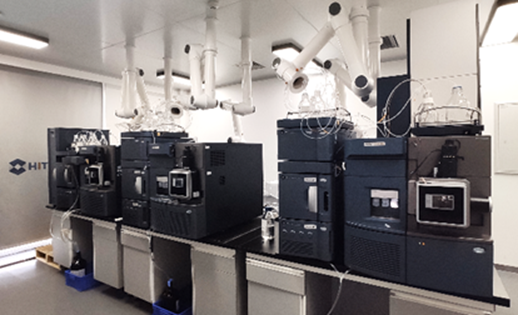HitGen featuring 200㎡ BSL-2 laboratories, SPF animal facilities, and NGS platforms. Through the strategic convergence of cutting-edge facilities and systematic research capabilities, covering early discovery to preclinical development services.
Bioanalysis services relying on HitGen's one-stop service platform for drug development, cover all stages from drug screening to PCC determination, including bioanalysis in pharmacokinetics, pharmacodynamics and toxicology.
Major technical services and platforms
We have developed ADME and DMPK evaluations for a variety of small molecule chemicals, PROTAC protein degradation targeting chimeras, oligonucleotides (ASO, siRNA, Aptamer, miRNA) and their delivery modifications including peptide, Gal-Nac, C16, C6, LNP, LA, EPA, DHA delivery modifications, and antibody-drug conjugate (ADC) drugs.
• In vitro ADME
Category | Content |
Physicochemical properties | Kinetic/thermodynamic solubility |
Solution stability (different pH, different buffers) | |
pKa | |
LogP/D | |
Absorption | Permeability (PAMPA, Caco-2) |
Transporter (P-gp) | |
Distribution | Blood-to-plasma ratio (B/P Ratio) |
Protein binding (plasma, brain tissue, microsome) | |
Metabolism | Matrices (plasma, tissue, BFS, SGF/SIF) |
Identification of metabolites and metabolic pathways in cells or subcellular component (microsome, S9, lysosome、recombinant enzymes, etc.) | |
Drug interaction | CYP (CYPs metabolic phenotype, CYP induction, CYP inhibition DDI and TDI) |
• In vivo PK
Commonly used species: mice and rats
Common tissue and matrix include whole blood, plasma, serum, brain, cerebrospinal fluid, urine, feces, liver, gastrointestinal tissue or other tissue.
In vivo PK service
Solvent and formulation screening
Tissue distribution
Bioavailability
In vivo identification of metabolites
PK/PD
Tissue distribution/ Blood-brain barrier permeability Kp,uu
• In vivo TK
TK/PD/TOX analysis
Sex difference
Dose-Response Relationship
Accumulation analysis
Active ingredient detection
Prodrug detection
Metabolite detection
Metabolite detection in TK samples
Immunogenicity assessment
• Identification of drug metabolites
Provides metabolite analysis and structural identification services for the analysis, isolation and identification of metabolites in biological matrices to support drug discovery and safety research. Research services range from optimal selection of lead compounds to the drug discovery phase.
Metabolic soft point analysis
Screening of (glutathione or cysteine)-trapped reactive metabolites
Identification of liver microsomal metabolites
Identification of hepatocyte metabolites
Identification of S9 metabolites
Identification of metabolites in plasma or whole blood in vitro
Identification of metabolites in rats and mice
Safety evaluation of metabolites
Tissue distribution (plasma, serum, liver, kidney, lung, brain, heart, spleen, muscle, skin, lymph, etc.)
Excretion /Identification of metabolites in vivo
Bioanalysis platform
• Small molecule drug research
PK/PD/TK study
In vitro ADME
In vivo PK/TK
Identification of metabolites
In vivo tissue distribution
• Small nucleic acid drug research
PK, TK, immunogenicity assessment, Cytokine & Biomarker in PD or TOX
In vitro evaluation of on-target/off-target effects
Stability in serum, lysosome, S9
Immunogenicity of PBMC
Evaluation of primary hepatocyte delivery/activity
In vivo tissue distribution
In vitro identification of metabolites
• LC-MS/MS/HRMS platform
High throughput sample tissue manager pre-system, high sensitivity and high-resolution mass spectrometry platform. The platform is equipped with multiple UPLC-DAD, UPLC-UV, UHPLC-FLD, LC-MS, LC-MS/MS and Qtof instruments and technologies, which can be used in development, validation and transfer of analytical methods in the Non-GLP analysis stage according to customer requirements.

Platform advantages
Rapid pharmacokinetic screening of multi-compounds in cassette PK
Multiple species: mice, rats
Multiple routes of administration: oral, intravenous injection, intraperitoneal injection, subcutaneous injection, etc.
Provide important PK parameters: half-life, area under the drug time curve, Cmax, etc.
Economizing compounds: About 1 mg of compounds can be evaluated
We use cookies to provide a better web experience.
By using our site, you acknowledge our use of cookies and please read our Cookie Notice for
More information